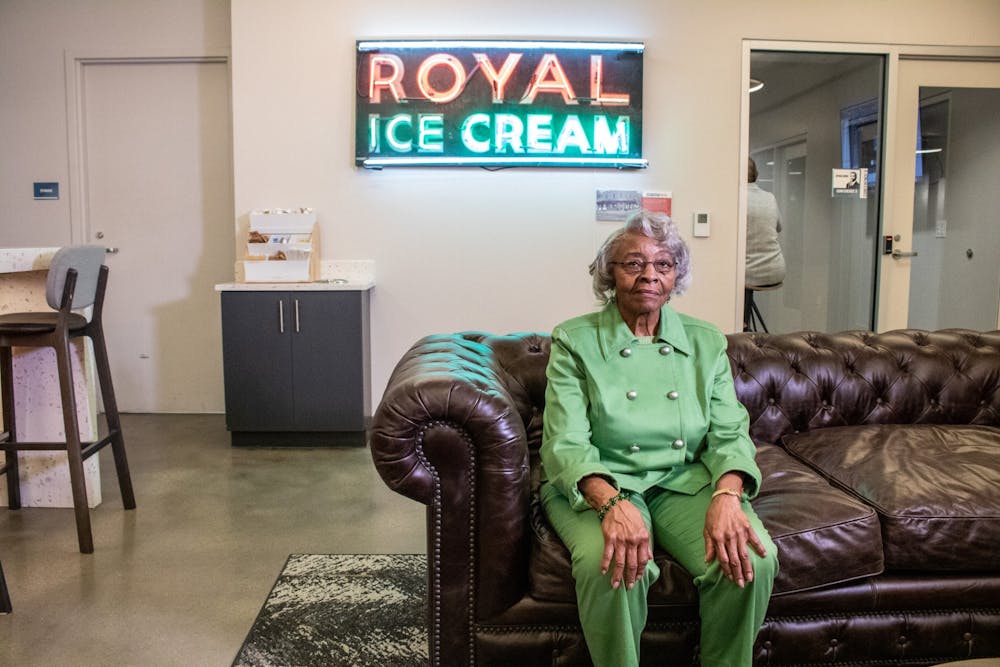The Royal Ice Cream Parlor is gone, but the girl from its 1957 sit-in remains.
As one of the last two remaining to tell the story, Virginia Williams recounts staging the first sit-in in Durham in a new light, as she rests on her laurels and awaits what the next day has to offer.
Williams maneuvers her way through town like other seniors. Early in the morning, she rides the public bus downtown, eats lunch at Ninth Street Bakery and returns home at around 1 or 2 p.m. to relax and watch the news.
Like many in her generation, Williams remains in a state of rest and order, even putting tasks as simple as a phone call into her calendar. Around town, Williams is approached by local community members asking questions about her life.
Williams is part of an older generation that faces a digital divide. A proud user of a landline phone that consists of cables and wires, she has no intention of buying a cellphone or receiving texts. She believes in leaving a voicemail if you want to reach her and relies on her sharp memory to match a voice to a face.
Raised in the small town of Seaboard, N.C., Williams never had an answer to the infamous kindergarten question, “what do you want to be when you grow up?”
She only knew one thing — that there was no life for her in Seaboard, where her family then lived on a “white man’s farm.”
Williams grew up watching her father get dressed in his Sunday best to quietly go to a meeting every three months. Her mother refused to tell her the details, until one day she finally admitted that Williams’s father was attending NAACP meetings.
The repressive environment of the Jim Crow South meant that Williams’ family often kept secrets out of fear. Williams adopted this mentality, secretly moving to Durham in 10th grade and finding a meeting like the ones her father used to attend.
“What kind of meeting is this?” Williams asked when a group of men invited her and two friends to a meeting at the Durham YWCA building as they were leaving out the front doors.
“A political meeting,” one of the men replied.
Williams agreed to go into the meeting and made the decision for her friends too. With about 20 men in attendance, the meeting wasn’t advertised, as many Black community members were afraid to disturb the peace — but support for the Civil Rights Movement was still growing.
“We sat quiet and didn’t say a word,” Williams said. That meeting was the initial discussion of the historic sit-in, even if she didn’t know it yet.
On June 23, 1957, there were only two things on the meeting agenda: Where would they stage the sit-in, and who was willing to go?
The sit-in, which predated the famous Greensboro sit-in, was located at the Royal Ice Cream Parlor off N. Roxboro St. and Dowd St., on a busy street. Today, a hidden sign covered by a tree is used as a state landmark of the site.
The parlor, a white-owned and segregated business in a Black neighborhood, required Black people to enter the parlor from the back door and wait at the steps until the waiter was finished taking orders from white people. After taking the orders from Black customers, the waiter would bring their ice cream in a bag or cup. They couldn’t sit in the parlor, forced to exit through the back door to eat their ice cream off the premises.
“They gon’ put all of our money in the same basket yet they’re not going to let us sit out in the yard in the car and eat it,” Williams said, explaining one of the reasons for choosing the location.
When the question of who was willing to go was raised at the meeting, Williams said that seven attendees — three women and four men — raised their hands, arriving at the parlor soon after. They came up the steps and waited on the steps in the usual manner.
But instead of waiting at the steps, they went straight to the booth.
The Royal Seven, as they came to be referred to, took the parlor’s best seats and stayed seated. They were refused service and arrested for trespassing.
Shortly after the sit-in, Williams was interviewed by the police.
“If you were my daughter, I would take you across my lap and spank you,” one officer said.
“If I were your daughter, I wouldn’t be over here for this,” Williams replied.
Williams was 20 years old at the time of the sit-in. Today, at 86 years old, one of Williams’s friends, Doris Bass Glenn, believes “she’s still a fighter, she just slowed down.”
Williams suffers from arthritis and doesn’t go out as much anymore. She also never married, had children or even drove a car. Williams devoted her life to civil disobedience because she believed her life was larger than herself. However, the number of people around Williams has become smaller, and her only sister has Alzheimer’s disease.
“I’m just worried … somebody will let me know if anything ever happens to her,” Bass Glenn said.
A hidden dichotomy exists with how Civil Rights heroes are idolized versus treated. The Royal Seven are commemorated across town: Williams is honored by a hidden mural that sits next to the Durham Arts Council, the original Royal Ice Cream sign hanging in the Museum of Durham History and an award from the St. Joseph AME Church.
Just like the Royal Ice Cream sign that sits on the site and appears blocked by a tree from a distance, Williams legacy has inadvertently been covered in the same manner — a legacy that should be illuminated and never forgotten.
Get The Chronicle straight to your inbox
Signup for our weekly newsletter. Cancel at any time.

